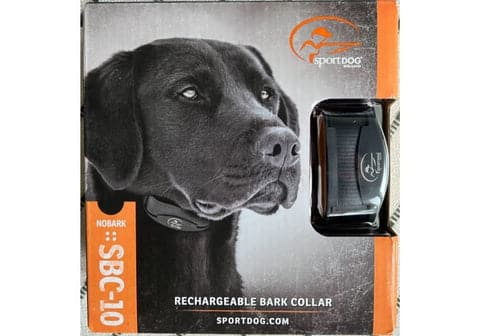Curious about whether or not your dog’s barking is reaching a point where intervention may be necessary? We’ve all been there, wondering if there’s a solution to the constant noise that can easily disrupt our households and even frustrate our neighbors. In this article, we’ll explore the signs that may indicate it’s time to consider using a bark collar for your beloved pooch. By understanding these key indicators, you can make an informed decision that benefits not only your four-legged friend, but also the harmony of your living environment.
Signs of Excessive Barking
Barking at Inappropriate Times
Excessive barking at inappropriate times may be a sign that your dog’s barking has become a problem. For example, if your dog barks excessively during the night and disturbs your neighbors or interrupts your sleep, it may be time to consider using a bark collar. Excessive barking in response to visitors or delivery personnel can also be a nuisance and may warrant the use of a bark collar.
Excessive Barking Duration
The duration of your dog’s barking can also indicate whether it has crossed the line into excessive barking. If your dog barks continuously for long periods of time, such as when left alone or when you’re not able to give it attention, it may be a sign that a bark collar could be beneficial.
Barking in Response to Triggers
Another sign of excessive barking is when your dog barks excessively in response to certain triggers, such as other animals, loud noises, or even specific people. While some level of alertness and protective barking is normal, if your dog becomes overly reactive and barks excessively in these situations, a bark collar may help to modify this behavior.
Considerations Before Using a Bark Collar
Health and Age of the Dog
Before considering the use of a bark collar, it’s essential to take into account your dog’s health and age. Puppies under six months old should not use bark collars due to their sensitive development stage. Additionally, dogs with certain health conditions may not be suitable candidates for bark collars, so it’s important to consult with a veterinarian to ensure it is safe for your dog to use one.
Training and Behavioral Modification Methods
Using a bark collar should not be the only method employed to address excessive barking. It is crucial to first attempt positive reinforcement training and behavioral modification techniques. Consult a professional dog trainer or behaviorist to guide you through these methods and to determine if a bark collar is an appropriate addition to your training plan.
Noise Sensitivity and Anxiety
Some dogs are more sensitive to noise and may find the corrective stimuli from a bark collar distressing. If your dog is easily frightened or shows signs of anxiety in response to loud sounds or sudden movements, a bark collar may not be the best solution. In these cases, it’s advisable to consult with a professional to explore alternative methods to manage excessive barking.
Feasibility of Behavioral Training
Considering the feasibility of behavioral training is essential when deciding whether to introduce a bark collar. Training requires time, consistency, and patience, so it’s important to assess if you have the resources necessary to dedicate to the training process. If behavioral training seems challenging or you are unable to commit to it, a bark collar may be a useful tool to assist in managing your dog’s excessive barking.
This image is property of petstek.com.
Types of Bark Collars
Shock Collars
Shock collars are a type of bark collar that deliver a static stimulation, commonly known as an electronic shock, to your dog when it barks excessively. The intensity of the shock can usually be adjusted, and it serves as a deterrent to discourage further barking. However, shock collars have been a topic of debate due to concerns about their potential harm and ethical implications.
Vibration Collars
Vibration collars are designed to produce a vibration or buzzing sensation when your dog barks excessively. This type of collar is less intrusive and controversial than shock collars since it does not involve delivering an electric shock to your dog. Instead, the vibrating sensation is intended to interrupt the barking behavior and redirect your dog’s attention.
Ultrasonic Collars
Ultrasonic collars emit a high-pitched sound that is only audible to dogs when they bark excessively. The sound is intended to deter barking without causing harm or discomfort to your dog. Ultrasonic collars are often preferred by dog owners who are concerned about the potential adverse effects of other collar types.
Citronella Collars
Citronella collars work by releasing a burst of citronella spray towards your dog when it barks excessively. Citronella is a scent that many dogs find unpleasant, and the sudden release of the spray can interrupt your dog’s barking behavior. Citronella collars are considered generally safe and humane, making them a popular choice among dog owners.
Effectiveness of Bark Collars
Understanding the Purpose of Bark Collars
Bark collars are designed to reduce and control excessive barking in dogs. The effectiveness of bark collars depends on various factors, including the type of collar used, the individual dog, and the consistency with which the collar is used. It’s important to note that while bark collars can be effective in reducing excessive barking, they should always be used in conjunction with proper training and behavioral modification techniques.
Benefits of Using a Bark Collar
One significant benefit of using a bark collar is that it can provide immediate feedback to your dog, helping to interrupt the barking behavior. This immediate feedback can help your dog associate the bark collar with the unwanted behavior, making it easier to teach them to reduce excessive barking over time. Bark collars can also be a valuable tool for individuals who may not have the time or resources to engage in extensive training.
Potential Drawbacks and Side Effects
While bark collars can be effective tools, they also have potential drawbacks and side effects. Dogs may become desensitized to the collar’s corrective stimuli over time, requiring a higher level of intensity for the collar to be effective. Additionally, some dogs may develop negative associations or anxiety towards the collar if not introduced and used correctly. It’s crucial to follow the manufacturer’s instructions and consult with a professional to minimize the risk of adverse effects.
This image is property of www.barkcontrol.com.au.
Alternative Methods of Managing Excessive Barking
Positive Reinforcement Training
Positive reinforcement training focuses on rewarding desired behaviors and ignoring or redirecting unwanted behaviors. By rewarding your dog with treats, praise, or affection when they behave appropriately and remain quiet, you can encourage them to reduce excessive barking. Positive reinforcement training can be effective in addressing the root causes of excessive barking, such as fear or anxiety.
Behavioral Modification Techniques
Behavioral modification techniques involve identifying and addressing the underlying causes of excessive barking. This may include desensitization and counter-conditioning, which aim to gradually expose your dog to triggers that result in barking, helping them learn to remain calm and quiet. Working with a professional dog trainer or behaviorist can provide guidance and support in implementing effective behavioral modification techniques.
Environmental Management
Managing your dog’s environment can also play a significant role in reducing excessive barking. This may involve minimizing triggers or distractions that lead to barking, such as closing curtains to limit visual stimuli or using white noise machines to mask outside noises. Creating a calm and quiet environment can help prevent your dog from becoming overly stimulated and barking excessively.
Consulting a Professional
If your dog’s excessive barking persists despite your best efforts, it may be beneficial to consult with a professional dog trainer or behaviorist. These professionals can assess your dog’s behavior, identify any underlying issues, and provide personalized training plans or behavior modification programs. Seeking professional guidance can increase the likelihood of successfully managing your dog’s excessive barking.
Considerations When Choosing a Bark Collar
Material and Durability
When selecting a bark collar, it’s important to consider the material and durability. Look for collars made from high-quality materials that are resistant to wear and tear. The collar should be able to withstand your dog’s daily activities and be durable enough to last for an extended period.
Correct Fit and Size
A proper fit is crucial for the effectiveness and safety of a bark collar. Ensure that the collar is neither too tight nor too loose, allowing your dog to move comfortably while preventing it from slipping off. Measure your dog’s neck circumference accurately and follow the manufacturer’s guidelines to select the appropriate size.
Battery Life and Rechargeable Options
Considering the battery life of a bark collar is essential, especially if you plan to use it regularly. Opt for collars with long-lasting batteries or rechargeable options to avoid frequent replacements or interruptions in usage. Rechargeable bark collars can be cost-effective and environmentally friendly alternatives.
Adjustable Settings and Sensitivity Levels
Choose a bark collar with adjustable settings and sensitivity levels to customize the training experience for your dog. The ability to adjust the intensity of stimuli can ensure that your dog receives appropriate feedback without unnecessary discomfort. This flexibility allows you to find the right balance for effective training and your dog’s comfort.
Ease of Use and Comfort for the Dog
A bark collar should be easy to use and user-friendly. Look for collars with clear instructions and intuitive controls to simplify the training process. Additionally, consider the comfort of the collar for your dog. Look for features like padded straps and lightweight materials to ensure your dog can wear the collar comfortably for extended periods.
This image is property of cdn.shopify.com.
Training Process with a Bark Collar
Introduction and Acclimation
Introducing your dog to a bark collar requires a gradual and positive approach. Allow your dog to explore the collar before putting it on, giving them the opportunity to sniff and become familiar with it. As you introduce the collar, provide treats and praise to create a positive association.
Correct Fitting and Placement
Ensuring a correct fit and placement of the bark collar is crucial for its effectiveness. Follow the manufacturer’s guidelines on how to correctly adjust and position the collar on your dog’s neck. A well-fitted collar should sit snugly without causing discomfort or hindering your dog’s movement.
Positive Reinforcement
When using a bark collar, it’s important to reinforce desired behavior with positive reinforcement techniques. Reward your dog with treats, praise, or playtime when they remain quiet or show signs of reduced barking. This positive reinforcement helps your dog understand that quiet behavior is rewarding.
Consistency and Regular Monitoring
Consistency is key when training with a bark collar. Use the collar consistently and as directed to reinforce the desired behavior. Regularly monitor your dog’s progress and adjust the collar’s settings or sensitivity levels if necessary. Continuously assess your dog’s response and consult with a professional if you encounter any difficulties.
Safety and Ethical Concerns
Potential Risks and Hazards
Although bark collars can be effective tools, it’s important to be aware of potential risks and hazards they may pose. Some dogs may experience discomfort, skin irritation, or rashes due to prolonged contact with the collar. Additionally, incorrect usage or excessive intensity levels can result in fear, anxiety, or even aggression. These risks highlight the importance of training, monitoring, and using bark collars responsibly.
Seeking Professional Advice
If you are unsure about whether a bark collar is suitable for your dog or how to properly train with one, seeking professional advice is strongly recommended. A professional dog trainer or behaviorist can assess your dog’s specific needs, provide guidance on the most appropriate training methods, and ensure the safe and ethical use of a bark collar.
Choosing the Right Collar for Your Dog
When considering the use of a bark collar, it’s vital to choose the right collar for your dog’s needs and temperament. Each dog is unique, and what works for one may not work for another. Take into account factors such as size, breed, temperament, and individual sensitivities when selecting a bark collar.
This image is property of s.turbifycdn.com.
Conclusion
Excessive barking can be a challenging issue for both dog owners and their neighbors. While a bark collar can be a useful tool to manage excessive barking, it should be used in conjunction with positive reinforcement training, behavioral modification techniques, and environmental management. When considering a bark collar, it’s crucial to prioritize your dog’s health, well-being, and comfort. Consulting with professionals and understanding your dog’s specific needs will help determine the most appropriate training methods and collar type for effective and humane results. Remember, the goal is not to completely silence your dog, but to encourage appropriate barking behavior and minimize disturbances while maintaining a happy and well-adjusted pet.













































